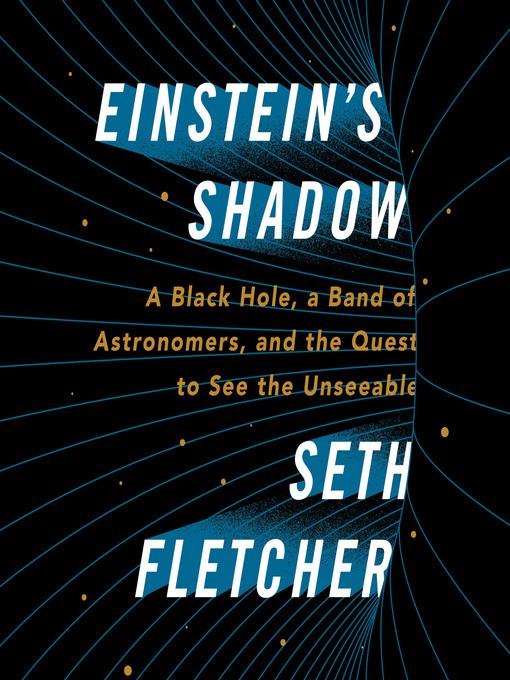
Einstein's Shadow
The Inside Story of Astronomers' Decades-Long Quest to Take the First Picture of a Black Hole
کتاب های مرتبط
- اطلاعات
- نقد و بررسی
- دیدگاه کاربران
نقد و بررسی

August 13, 2018
Fletcher (Bottled Lightning), Scientific American’s chief features editor, falls short in his attempt to engage readers in the story of a group of astronomers, led by astrophysicist Shep Doeleman, “on a quest to take the first picture of a black hole” that began in 2012. Noting that “no one has ever gotten a direct look” at one, Fletcher makes plain the effort’s value, citing how important it could be to reconciling Einstein’s theory of relativity with quantum mechanics. He starts intriguingly, by grounding the project in human vanity, recounting a discussion among astronomers working on the Event Horizon Telescope—an array of radio telescopes spread over several continents—that he realized was actually about “who gets their name on Nobel Prize.” Unfortunately, despite the author’s best efforts, making the phenomenon of black holes comprehensible proves an uphill battle. Unlike the best popular science books, this narrative doesn’t make the scientific concepts sufficiently clear to the lay reader.

November 1, 2018
Fletcher (Bottled Lightning) guides readers through space and time, from a 1979 total solar eclipse in Washington State to the more current-day MIT Haystack Observatory, from remote telescopes around the world to the center of the Milky Way and back again. The common thread weaving years and places is astronomer Shep Doeleman, whose quest to see the event horizon of Sagittarius A*, the super massive black hole at the center of our galaxy, has spanned continents and decades of groundbreaking work. Through complex collaborations and the roller coaster of scientific funding, Doeleman pulled together scientists all over the world to build an Earth-sized radio telescope, the Event Horizon Telescope (EHT). Fletcher's telling of the quest to gain access to and manage the telescopes making up the EHT has readers sharing in the anxiety of harsh weather events and equipment malfunctions but also in the jubilation of hard-won data. Fletcher manages to humanize a complicated scientific project while providing readers with a comprehensive guide to the cosmos. VERDICT Recommended for all readers interested in astronomy, general science, the nature of scientific collaboration, or humanity's search to understand the universe.{amp}mdash;Melissa Engleman, Univ. of Tennessee at Martin
Copyright 2018 Library Journal, LLC Used with permission.

Starred review from September 1, 2018
A veteran science journalist builds a fascinating narrative based on his exclusive access to a group of astronomers bent on photographing a black hole, a near-impossible feat of Nobel Prize proportions.For more than five years, Scientific American features editor Fletcher (Bottled Lightning: Superbatteries, Electric Cars, and the New Lithium Economy, 2011, etc.) followed astronomer Shep Doeleman and his team of intrepid scientists as they assembled the largest array of radio telescopes in the world, the Event Horizon Telescope, in the hope of imaging a black hole. The author excels at bringing to life not just the researchers and experimentalists, whose quirks and passions add much to the story, but the cutting-edge science driving their epic quest. Despite their ubiquity in popular culture, black holes have never been directly observed. A mountain of theoretical evidence posits that they exist in abundance in the universe. Most intriguing is that scientists are almost positive that a supermassive black hole known as Sagittarius A* lies in the center of our Milky Way galaxy. Getting a picture of Sagittarius A* is Doeleman's white whale. Not only would it be the first direct evidence of a black hole; it also may reveal long-sought-after secrets of the universe--maybe even hint at a so-called "Theory of Everything." With stakes this high and writing this lucid, readers will be drawn into the narrative as easily as matter being drawn toward the event horizon itself. The hypotheses, experiments, team-building, and bureaucratic wrangling that Fletcher so beautifully describes perfectly encapsulate modern science, and it's a rare treat to have an insider's look at an ongoing endeavor this monumental. The author also includes a helpful guide to acronyms and abbreviations and a cast of characters.Supermassive black holes, a virtual telescope the size of the Earth, trailblazing astronomers who test the boundaries of modern science--this is scientific storytelling at its best.
COPYRIGHT(2018) Kirkus Reviews, ALL RIGHTS RESERVED.

September 15, 2018
This engaging narrative follows an international team of scientists working together to take the first picture of a black hole, namely Sagittarius A*. Fletcher (Bottled Lightning?, 2011) spent five years following one of the scientists, Shep Doeleman, and his team as they built a virtual radio observatory the size of Earth by assembling a worldwide network of radio telescopes called the Event Horizon Telescope. Readers get a front-row seat to the action as Fletcher joins the team on their conferences and meetings and even to visit telescopes around the world for testing. The explanations of astrophysics topics are clear, and Doeleman's challenge is a compelling one: he is in a race to secure funding, get international cooperation from observatories around the world, and beat the clock, as there is only a small window (a few weeks in spring) when everything is aligned for the perfect shot?and that's only if the weather cooperates at all of the sites. Captivating and informative, this text will appeal to those with an interest in the topic and to general readers alike.(Reprinted with permission of Booklist, copyright 2018, American Library Association.)

























دیدگاه کاربران